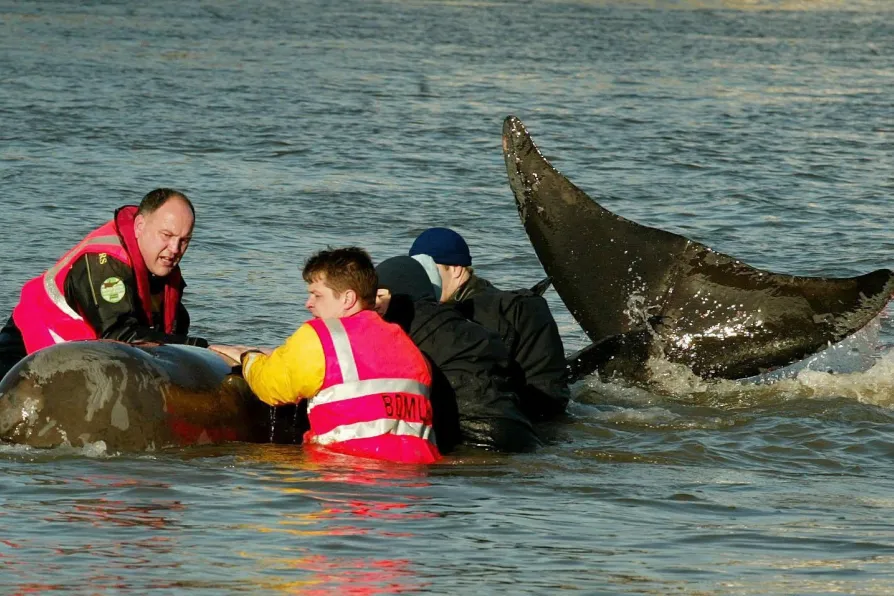Durham Miners’ Association general secretary ALAN MARDGHUM speaks to Ben Chacko ahead of Gala Day 2025

 Rescuers battle to save a 15ft northern bottle-nosed whale in the Thames in 2006
Rescuers battle to save a 15ft northern bottle-nosed whale in the Thames in 2006
THE 27-foot-long humpback whale that died in the Thames earlier this month brings the total number of whales seen in the river to well over 50 in just the last 10 years. The young whale died from injuries from being hit by a ship before she reached the river.
The survival of “Benny” the Arctic beluga whale, which made the Thames estuary its home from July to Christmas last year was one of the most unusual whale sighting in London’s river.
As well as whales well over 2,000 seals and some 450 porpoises and dolphins have been sighted in the river Thames in the last decade. It is not unusual to see seals basking on jetties or even the decks off small moored boats in the middle of London.
Ten years ago the sight of a large whale swimming under Westminster Bridge before beaching at Battersea Park proved a source of wonder for the many Londoners who came out to see it. The media went mad.
They called it the “Thames Whale.” It was a northern bottlenose, a relatively rare species of beaked whale that is not a regular visitor to the Thames.
It is one of the deepest-diving marine mammals, capable of getting to depths of 1,400m, where it hunts giant squid in the darkness of the deep sea.
The stranding of the Thames Whale and the subsequent operation to release it at sea prompted rolling news coverage, with TV news crews following the rescue down the river by helicopter.
Sadly, the whale died before it could reach the mouth of the Thames and its skeleton is now on display in the Natural History Museum in South Kensington.
Much of the change over that last decade is part of a general clean-up of the river that has led to an amazing increase in fish and other wildlife in the capital’s river.
Another factor identified by the Zoological Society of London (ZSL), which monitors river wildlife, is the new tall buildings have made sea mammals easier to spot.
It may well be the number of relatively new tall buildings like No 1 Canada Square which give many more chances to spot whales and other wildlife in the river below.
ZSL public surveys have also reported seals being seen as far upstream as Hampton Court, with dolphins and porpoises sighted at Teddington lock in south-west London.
Joanna Barker, European conservation projects manager at ZSL, tells us: “People are often surprised to hear that marine mammals are regularly spotted in central London.
“As top predators, their presence is a good sign that the Thames is getting cleaner and supporting many fish species.
“The presence of these animals is also a great example of how urban environments are important for wildlife.”
The Thames estuary up to the capital itself was almost biologically dead 50 years ago. Now it is home to a thriving ecosystem, with at least 120 species of fish being found in its waters. Amazingly two species of seahorse are among them.
European eels, for centuries a staple of Cockney cuisine, are critically endangered but are coming back in increasing numbers to the Thames.
Conservation efforts include the removal of barriers which stop eels migrating upstream.
Now that the river contains enough fish for larger predators to survive two species of shark, the tope and the smooth-hound, are breeding in the estuary.
Seal populations have doubled in five years, with about 3,000 grey and harbour seals now calling the river home.
Seal numbers have grown, with large numbers of seal pups being born in the river. Due to the large amounts of iron salts in the river mud many of these seals have a unique ginger coat. Harbour porpoises too are becoming regular visitors to the river.
Fifty whales in 10 years might sound impressive but the total could have been knocked out of the water if a pod of pilot whales that swam down the East Anglia coast in November 2014 had swum up the Thames instead of choosing the river Blackwater just a few miles along the Essex coast.
Pilot whales travel in huge pods. As many as 600 have come ashore in a single stranding, most pods, including the one that almost reached the Thames, are between 50 and 100 animals.
We should not forget that London was once a major centre of the European whaling industry.
In the 1700s, fleets of whaling vessels would leave Greenwich and Surrey Quays to hunt for populations of baleen whales in the North Sea, North Atlantic and Arctic regions.
A single large whale could be worth half a million pounds in today’s money.
The remains of one such whale were discovered in Bay Wharf, Greenwich, in 2010. It is thought that this north Atlantic right whale was caught at the mouth of the Thames around 200 years ago, before being dragged to Greenwich where it would have been slaughtered and processed for its oil and meat.
The 23-foot skeleton of this whale is now on display in the Museum of London Docklands in Canary Wharf.
Marks on its bones show it was repeatedly stabbed with harpoons so as to lose as much blood as possible before being hauled onto land.
Two Rotherhithe pubs, the Ship and Whale pub at Gulliver Street and the Moby Dick at Russell Place are reminders of a time when London was home to a substantial whaling fleet as well as the refineries that processed whale oil for use in lamps and cosmetics.
Greenland Dock, now posh flats in Rotherhithe was, in the 1700s, one of the largest man-made docks in the world built to hold the huge whaling fleet that found a rich bloody harvest in the Arctic and Greenland.
London’s whaling ended in the early 19th century as the whaling fleets moved north to other British ports and then when the Arctic whale stock had been depleted to the other end of the world where the Falklands and South Georgia allowed them to decimate Antarctic stocks.
During that next couple of centuries the Thames became a foul-smelling sewer as riverside housing and industry polluted the waters with no thoughts for the wildlife.
By the 1960s the Thames was declared biologically dead. Few believed that it could ever recover and sometimes it seemed even fewer cared.
However a few brave and inspired souls refused to give up. They campaigned and worked tirelessly to clean up the river waters.
We should perhaps look at the turnaround in its fate as inspiration for the campaigns of groups like Extinction Rebellion which are trying to reverse the same thing in the seas, the air and in our climate.
If you are lucky enough to see a marine mammal in the Thames, do not approach or touch it. Keep 50 metres away and report your sighting to zsl.org/inthethames or phone 0800 6520-333.



















